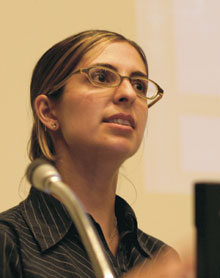AI brings mind to bear on matter

Rima Brek, an artificial intelligence specialist from renowned video game developer Ubisoft, delivered a presentation on AI in computer gaming during the Artificial Intelligence Symposium last week.
Photo by Jason Gondziola
Minds and machines were on the agenda at the Artificial Intelligence Symposium, which took place at Concordia from March 23 to April 1. The Concordia Computer Science Society (CCCS) organized it to inform the public on a burgeoning field.
“I think that artificial intelligence is a domain that not many people know about,” said Behrouz Bayat, VP external for the CCCS. He looked at the research interests of Concordia and local professors and designed the conference around four big topics in artificial intelligence: artificial life, machine learning, automated reasoning and applied AI.
“For artificial intelligence at the university, it’s a great way of making it visible,” said Sabine Bergler, an associate professor in Computer Science who assisted Bayat in coordinating the conference. “This goes in-depth. It was a lot more research-oriented than we can be in the classroom.”
Professor Peter Grogono, head of the Software Engineering program, delivered a talk entitled “Laws and Life,” which he explained as an approach to artificial life.
“The point of the title is that we want to set up a computer world in which there are a certain number of fixed laws, which you could think of as corresponding to the laws of physics or the laws of chemistry,” he said.
“The life part of the title is the agents that evolve in this world according to these laws. We want the agents to have complex and interesting behaviour, even though the underlying laws are quite simple.”
This area of artificial intelligence research can have powerful applications. Evolving artificial life systems are proficient problem-solvers when it comes to optimization and shortest-route puzzles, and have even been used to create entirely new solutions with very little initial input.
“It’s becoming good enough that you can use it for design. A control system was designed by an artificial design program,” Grogono said. “It was evolved—a thousand Pentiums running for a month produced this design with very little input. They have applied for a patent.”
Volker Haarslev, an associate professor in Computer Science, delivered a speech on the subject of semantic webs and automated reasoning.
The current World Wide Web is limited, according to Haarslev, in that you have to be human to understand its contents. As an example, he said that searching for “cook” on Google results in hits from pages about professional cooks, the Cook Islands, and the Thomas Cook travel agency. The system only matches the word, not the context.
“The goal [of semantic web] is that we have programs, we call them agents, that can understand web pages and other knowledge or data sources in the web,” he said. “The idea is that we take the standard web and we extend it in a way that it’s also very suitable for programs or non human agents that can understand the contents of web pages.”
This is achieved by storing extra information in web pages, so that ambiguous content words can be understood in their proper context. In the future, advanced search engines could match words from the documented pages to dictionaries, and could understand the difference between “cook” when referencing the island, the agency or the profession.
The conference concluded on April 1 with a presentation from Rima Brek, a specialist in artificial intelligence from Ubisoft, who gave an overview of applied AI in computer gaming. The organizers were pleased with the turnout.